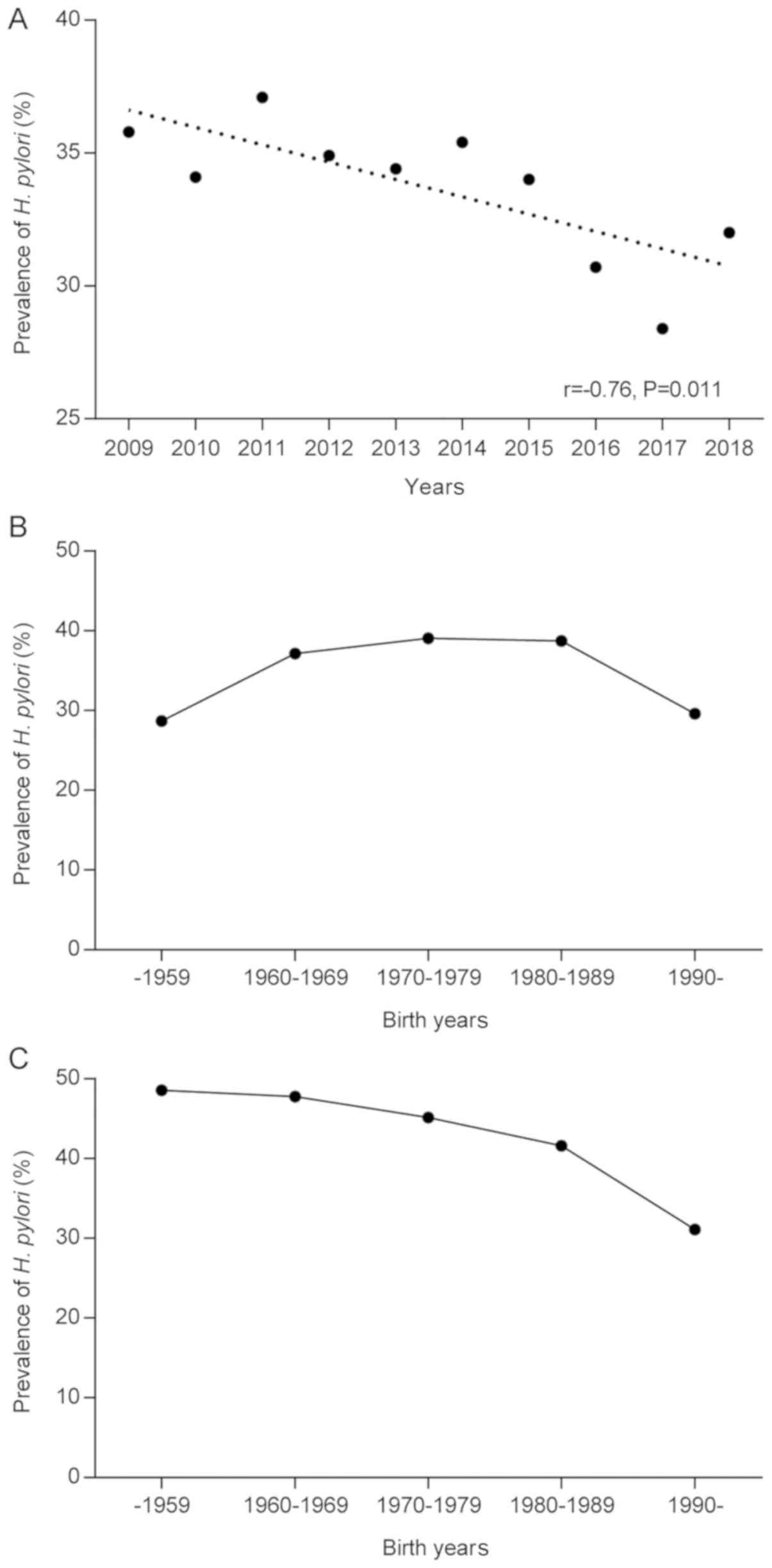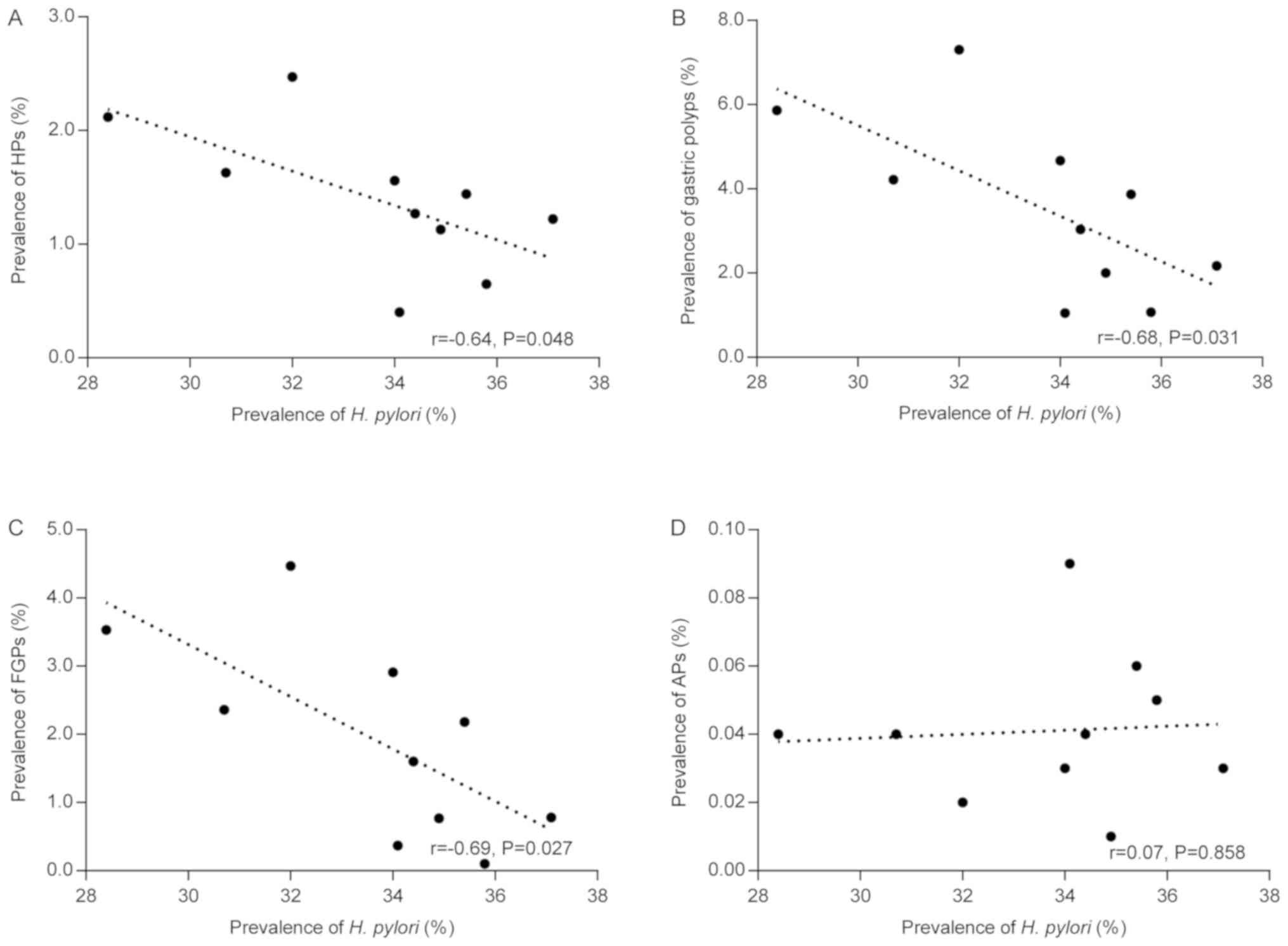|
1
|
Elhanafi S, Saadi M, Lou W,
Mallawaarachchi I, Dwivedi A, Zuckerman M and Othman MO: Gastric
polyps: Association with Helicobacter pylori status and the
pathology of the surrounding mucosa, a cross sectional study. World
J Gastrointest Endosc. 7:995–1002. 2015.PubMed/NCBI View Article : Google Scholar
|
|
2
|
Carmack SW, Genta RM, Schuler CM and
Saboorian MH: The current spectrum of gastric polyps: A 1-year
national study of over 120,000 patients. Am J Gastroenterol.
104:1524–1532. 2009.PubMed/NCBI View Article : Google Scholar
|
|
3
|
Fan NN, Yang J, Sun G, Lu ZS, Ling Hu EQ,
Wang XD and Yang YS: Changes in the spectrum of gastric polyps in
the Chinese population. World J Gastroenterol. 21:9758–9764.
2015.PubMed/NCBI View Article : Google Scholar
|
|
4
|
Cao H, Wang B, Zhang Z, Zhang H and Qu R:
Distribution trends of gastric polyps: An endoscopy database
analysis of 24 121 northern Chinese patients. J Gastroenterol
Hepatol. 27:1175–1180. 2012.PubMed/NCBI View Article : Google Scholar
|
|
5
|
Velázquez-Dohorn ME, López-Durand CF and
Gamboa-Domínguez A: Changing trends in gastric polyps. Rev Invest
Clin. 70:40–45. 2018.PubMed/NCBI View Article : Google Scholar
|
|
6
|
Sonnenberg A and Genta RM: Prevalence of
benign gastric polyps in a large pathology database. Dig Liver Dis.
47:164–169. 2015.PubMed/NCBI View Article : Google Scholar
|
|
7
|
Kyburz A and Muller A: Helicobacter
pylori and extragastric diseases. Curr Top Microbiol Immunol.
400:325–347. 2017.PubMed/NCBI View Article : Google Scholar
|
|
8
|
O'Morain NR, Dore MP, O'Connor AJP,
Gisbert JP and O'Morain CA: Treatment of Helicobacter pylori
infection in 2018. Helicobacter 23. (Suppl
1)(e12519)2018.PubMed/NCBI View Article : Google Scholar
|
|
9
|
Nam SY, Park BJ, Ryu KH and Nam JH: Effect
of Helicobacter pylori infection and its eradication on the
fate of gastric polyps. Eur J Gastroenterol Hepatol. 28:449–454.
2016.PubMed/NCBI View Article : Google Scholar
|
|
10
|
Kume K, Hirakoba M, Murata I, Yoshikawa I
and Otsuki M: Disappearance of both MALT lymphoma and hyperplastic
polyps in the stomach after eradication of Helicobacter
pylori. Am J Gastroenterol. 96:2796–2797. 2001.PubMed/NCBI View Article : Google Scholar
|
|
11
|
Ji F, Wang ZW, Ning JW, Wang QY, Chen JY
and Li YM: Effect of drug treatment on hyperplastic gastric polyps
infected with Helicobacter pylori: A randomized, controlled
trial. World J Gastroenterol. 12:1770–1773. 2006.PubMed/NCBI View Article : Google Scholar
|
|
12
|
Xie C and Lu NH: Review: Clinical
management of Helicobacter pylori infection in China.
Helicobacter. 20:1–10. 2015.PubMed/NCBI View Article : Google Scholar
|
|
13
|
Yu X, Yang X, Yang T, Dong Q, Wang L and
Feng L: Decreasing prevalence of Helicobacter pylori
according to birth cohorts in urban China. Turk J Gastroenterol.
28:94–97. 2017.PubMed/NCBI View Article : Google Scholar
|
|
14
|
Goddard AF, Badreldin R, Pritchard DM,
Walker MM and Warren B: British Society of Gastroenterology. The
management of gastric polyps. Gut. 59:1270–1276. 2010.PubMed/NCBI View Article : Google Scholar
|
|
15
|
Peretz A, Fuchs T, Livovsky DM, Turvall E,
Pappo O and Ackerman Z: The changing histological pattern of
gastric polyps in an ethnically heterogeneous population. Scand J
Gastroenterol. 47:907–913. 2012.PubMed/NCBI View Article : Google Scholar
|
|
16
|
Stolte M, Sticht T, Eidt S, Ebert D and
Finkenzeller G: Frequency, location, and age and sex distribution
of various types of gastric polyp. Endoscopy. 26:659–665.
1994.PubMed/NCBI View Article : Google Scholar
|
|
17
|
Dore MP, Pes GM, Rocchi C, Loria MF, Soro
S and Bassotti G: Are gastric hyperplastic polyps an additional
manifestation in celiac disease?: Results from a retrospective
study. Medicine (Baltimore). 96(e5923)2017.PubMed/NCBI View Article : Google Scholar
|
|
18
|
Nagy P, Johansson S and Molloy-Bland M:
Systematic review of time trends in the prevalence of
Helicobacter pylori infection in China and the USA. Gut
pathogens. 8(8)2016.PubMed/NCBI View Article : Google Scholar
|
|
19
|
Hooi JKY, Lai WY, Ng WK, Suen MMY,
Underwood FE, Tanyingoh D, Malfertheiner P, Graham DY, Wong VWS, Wu
JCY, et al: Global prevalence of Helicobacter pylori
infection: Systematic review and meta-analysis. Gastroenterology.
153:420–429. 2017.PubMed/NCBI View Article : Google Scholar
|
|
20
|
Takeuchi C, Yamamichi N, Shimamoto T,
Takahashi Y, Mitsushima T and Koike K: Gastric polyps diagnosed by
double-contrast upper gastrointestinal barium X-ray radiography
mostly arise from the Helicobacter pylori-negative stomach
with low risk of gastric cancer in Japan. Gastric Cancer.
20:314–321. 2017.PubMed/NCBI View Article : Google Scholar
|
|
21
|
Sonnenberg A, Lash RH and Genta RM: A
national study of Helicobacter pylori infection in gastric
biopsy specimens. Gastroenterology. 139:1894–1901.e2; quiz e12.
2010.PubMed/NCBI View Article : Google Scholar
|
|
22
|
Jiang JX, Liu Q, Zhao B, Zhang HH, Sang
HM, Djaleel SM, Zhang GX and Xu SF: Risk factors for intestinal
metaplasia in a southeastern Chinese population: An analysis of
28,745 cases. J Cancer Res Clin Oncol. 143:409–418. 2017.PubMed/NCBI View Article : Google Scholar
|
|
23
|
Rothenbacher D, Blaser MJ, Bode G and
Brenner H: Inverse relationship between gastric colonization of
Helicobacter pylori and diarrheal illnesses in children:
Results of a population-based cross-sectional study. J Infect Dis.
182:1446–1449. 2000.PubMed/NCBI View
Article : Google Scholar
|
|
24
|
Cohen D, Shoham O, Orr N and Muhsen K: An
inverse and independent association between Helicobacter
pylori infection and the incidence of shigellosis and other
diarrheal diseases. Clin Infect Dis. 54:e35–e42. 2012.PubMed/NCBI View Article : Google Scholar
|
|
25
|
Wang Z, Shaheen NJ, Whiteman DC, Anderson
LA, Vaughan TL, Corley DA, El-Serag HB, Rubenstein JH and Thrift
AP: Helicobacter pylori infection is associated with reduced
risk of Barrett's esophagus: An analysis of the Barrett's and
esophageal adenocarcinoma consortium. Am J Gastroenterol.
113:1148–1155. 2018.PubMed/NCBI View Article : Google Scholar
|
|
26
|
Wu JC, Sung JJ, Ng EK, Go MY, Chan WB,
Chan FK, Leung WK, Choi CL and Chung SC: Prevalence and
distribution of Helicobacter pylori in gastroesophageal
reflux disease: A study from the East. Am J Gastroenterol.
94:1790–1794. 1999.PubMed/NCBI View Article : Google Scholar
|
|
27
|
Malaty HM, El-Kasabany A, Graham DY,
Miller CC, Reddy SG, Srinivasan SR, Yamaoka Y and Berenson GS: Age
at acquisition of Helicobacter pylori infection: A follow-up
study from infancy to adulthood. Lancet. 359:931–935.
2002.PubMed/NCBI View Article : Google Scholar
|
|
28
|
Breckan RK, Paulssen EJ, Asfeldt AM,
Kvamme JM, Straume B and Florholmen J: The all-age prevalence of
Helicobacter pylori infection and potential transmission
routes. A population-based study. Helicobacter. 21:586–595.
2016.PubMed/NCBI View Article : Google Scholar
|
|
29
|
Nam SY, Park BJ, Ryu KH and Nam JH: Effect
of Helicobacter pylori eradication on the regression of
gastric polyps in national cancer screening program. Korean J
Intern Med. 33:506–511. 2018.PubMed/NCBI View Article : Google Scholar
|
|
30
|
Kang KH, Hwang SH, Kim D, Kim DH, Kim SY,
Hyun JJ, Jung SW, Koo JS, Jung YK, Yim HJ and Lee SW: The effect of
Helicobacter pylori infection on recurrence of gastric
hyperplastic polyp after endoscopic removal. Korean J
Gastroenterol. 71:213–218. 2018.PubMed/NCBI View Article : Google Scholar : (In Korean).
|
|
31
|
Miyamoto S, Kato M, Matsuda K, Abiko S,
Tsuda M, Mizushima T, Yamamoto K, Ono S, Kudo T, Shimizu Y, et al:
Gastric hyperplastic polyps associated with proton pump inhibitor
use in a case without a history of Helicobacter pylori
infection. Intern Med. 56:1825–1829. 2017.PubMed/NCBI View Article : Google Scholar
|
|
32
|
Kinoshita S, Nishizawa T, Mori H and
Kikuchi M: Haemorrhagic gastric hyperplastic polyps associated with
long-term use of proton pump inhibitor in a case without
Helicobacter pylori infection. J Clin Pharm Ther.
44(493)2019.PubMed/NCBI View Article : Google Scholar
|
|
33
|
Chalermwatanachai T, Vilchez-Vargas R,
Holtappels G, Lacoere T, Jáuregui R, Kerckhof FM, Pieper DH, Van de
Wiele T, Vaneechoutte M, Van Zele T and Bachert C: Chronic
rhinosinusitis with nasal polyps is characterized by dysbacteriosis
of the nasal microbiota. Sci Rep. 8(7926)2018.PubMed/NCBI View Article : Google Scholar
|
|
34
|
Mangifesta M, Mancabelli L, Milani C,
Gaiani F, de'Angelis N, de'Angelis GL, van Sinderen D, Ventura M
and Turroni F: Mucosal microbiota of intestinal polyps reveals
putative biomarkers of colorectal cancer. Sci Rep.
8(13974)2018.PubMed/NCBI View Article : Google Scholar
|
|
35
|
Rezasoltani S, Asadzadeh Aghdaei H, Dabiri
H, Akhavan Sepahi A, Modarressi MH and Nazemalhosseini Mojarad E:
The association between fecal microbiota and different types of
colorectal polyp as precursors of colorectal cancer. Microb Pathog.
124:244–249. 2018.PubMed/NCBI View Article : Google Scholar
|
|
36
|
Peters BA, Dominianni C, Shapiro JA,
Church TR, Wu J, Miller G, Yuen E, Freiman H, Lustbader I, Salik J,
et al: The gut microbiota in conventional and serrated precursors
of colorectal cancer. Microbiome. 4(69)2016.PubMed/NCBI View Article : Google Scholar
|
|
37
|
Coker OO, Dai Z, Nie Y, Zhao G, Cao L,
Nakatsu G, Wu WK, Wong SH, Chen Z, Sung JJY and Yu J: Mucosal
microbiome dysbiosis in gastric carcinogenesis. Gut. 67:1024–1032.
2018.PubMed/NCBI View Article : Google Scholar
|
|
38
|
Printz C: Long-term antibiotic use
associated with cancer-causing polyps. Cancer. 123:2996–2997.
2017.PubMed/NCBI View Article : Google Scholar
|
|
39
|
Jo HJ, Kim J, Kim N, Park JH, Nam RH, Seok
YJ, Kim YR, Kim JS, Kim JM, Kim JM, et al: Analysis of gastric
microbiota by pyrosequencing: Minor role of bacteria other than
Helicobacter pylori in the gastric carcinogenesis.
Helicobacter. 21:364–374. 2016.PubMed/NCBI View Article : Google Scholar
|
|
40
|
Li TH, Qin Y, Sham PC, Lau KS, Chu KM and
Leung WK: Alterations in gastric microbiota after H. pylori
eradication and in different histological stages of gastric
carcinogenesis. Sci Rep. 7(44935)2017.PubMed/NCBI View Article : Google Scholar
|
|
41
|
Gantuya B, El-Serag HB, Matsumoto T, Ajami
NJ, Oyuntsetseg K, Azzaya D, Uchida T and Yamaoka Y: Gastric
microbiota in Helicobacter pylori-negative and -positive
gastritis among high incidence of gastric cancer area. Cancers
(Basel). 11(pii: E504)2019.PubMed/NCBI View Article : Google Scholar
|


















